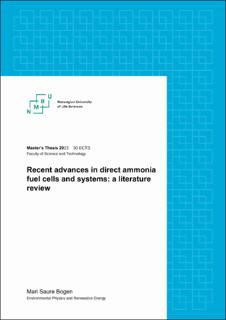| dc.description.abstract | Ammonia has over the last two decades emerged as a promising carbon-free energy carrier due to its higher volumetric energy density and more widely developed distribution infrastructure compared to hydrogen. This makes ammonia a more encouraging alternative with regard to transportation and energy storage in a low-carbon energy future.
The direct use of ammonia in fuel cells has been investigated through a literature review on solid oxide fuel cells (proton conducting (PCFC) and oxide ion conducting (SOFC-O)), and anion exchange membrane (AEMFC) fuel cell technologies. The study has been executed with a particular focus on the most recent advances, in addition to a mapping of which challenges to overcome to enable commercial relevance for these technologies.
Oxide ion conducting SOFC-O stands out as the most mature technology for ammonia, with performances similar to H$_{2}$ in larger systems. The proton-conducting PCFC is following close behind with equivalent peak power densities as SOFC-O at cell-level. However, the scale-up within PCFC has not yet been reported for ammonia-fed PCFC. Stability and durability are challenges for both solid oxide technologies, where nickel nitriding is the major degradation mechanism. Another hindrance is the unsatisfactory ammonia decomposition at lowered operating temperatures.
The anion exchange membrane fuel cell emerges as a promising, yet immature low-temperature technology that has shown considerable advancements in the last decade. The most notable challenges here are slow ammonia oxidation, membrane stability problems, a significant amount of fuel crossover, and poor interface charge transfer between the electrodes and the membrane. | |
